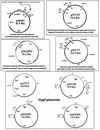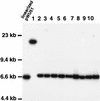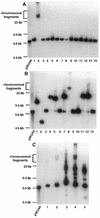Electrotransformation and expression of bacterial genes encoding hygromycin phosphotransferase and beta-galactosidase in the pathogenic fungus Histoplasma capsulatum
- PMID: 9529100
- PMCID: PMC108107
- DOI: 10.1128/IAI.66.4.1697-1707.1998
Electrotransformation and expression of bacterial genes encoding hygromycin phosphotransferase and beta-galactosidase in the pathogenic fungus Histoplasma capsulatum
Abstract
We developed an efficient electrotransformation system for the pathogenic fungus Histoplasma capsulatum and used it to examine the effects of features of the transforming DNA on transformation efficiency and fate of the transforming DNA and to demonstrate fungal expression of two recombinant Escherichia coli genes, hph and lacZ. Linearized DNA and plasmids containing Histoplasma telomeric sequences showed the greatest transformation efficiencies, while the plasmid vector had no significant effect, nor did the derivation of the selectable URA5 marker (native Histoplasma gene or a heterologous Podospora anserina gene). Electrotransformation resulted in more frequent multimerization, other modification, or possibly chromosomal integration of transforming telomeric plasmids when saturating amounts of DNA were used, but this effect was not observed with smaller amounts of transforming DNA. We developed another selection system using a hygromycin B resistance marker from plasmid pAN7-1, consisting of the E. coli hph gene flanked by Aspergillus nidulans promoter and terminator sequences. Much of the heterologous fungal sequences could be removed without compromising function in H. capsulatum, allowing construction of a substantially smaller effective marker fragment. Transformation efficiency increased when nonselective conditions were maintained for a time after electrotransformation before selection with the protein synthesis inhibitor hygromycin B was imposed. Finally, we constructed a readily detectable and quantifiable reporter gene by fusing Histoplasma URA5 with E. coli lacZ, resulting in expression of functional beta-galactosidase in H. capsulatum. Demonstration of expression of bacterial genes as effective selectable markers and reporters, together with a highly efficient electrotransformation system, provide valuable approaches for molecular genetic analysis and manipulation of H. capsulatum, which have proven useful for examination of targeted gene disruption, regulated gene expression, and potential virulence determinants in this fungus.
Figures




References
-
- Aguirre J. Spatial and temporal controls of the Aspergillus brlA developmental regulatory gene. Mol Microbiol. 1993;8:211–218. - PubMed
-
- Ausubel F M, Brent R, Kingston R E, Moore D D, Seidman J G, Smith J A, Struhl K, editors. Current protocols in molecular biology. New York, N.Y: John Wiley & Sons, Inc.; 1994. . (CD-ROM version.)
-
- Brown D H, Jr, Slobodkin I V, Kumamoto C A. Stable transformation and regulated expression of an inducible reporter construct in Candida albicans using restriction enzyme-mediated integration. Mol Gen Genet. 1996;251:75–80. - PubMed
Publication types
MeSH terms
Substances
Grants and funding
LinkOut - more resources
Full Text Sources
Other Literature Sources

